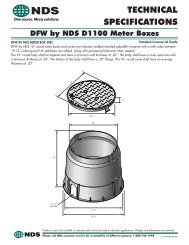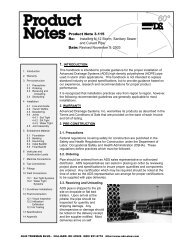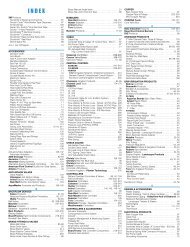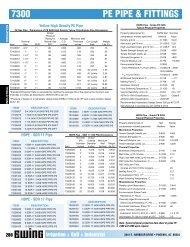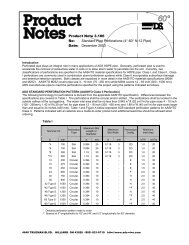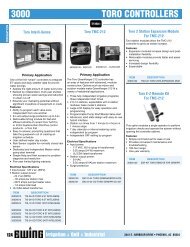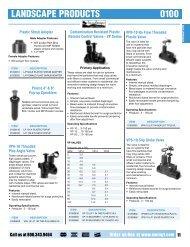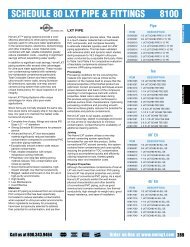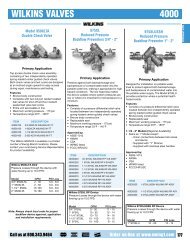LIT-060 Hunter 2004-2005 Product Catalog - Ewing Irrigation
LIT-060 Hunter 2004-2005 Product Catalog - Ewing Irrigation
LIT-060 Hunter 2004-2005 Product Catalog - Ewing Irrigation
You also want an ePaper? Increase the reach of your titles
YUMPU automatically turns print PDFs into web optimized ePapers that Google loves.
Precipitation RatesA brief overview for the irrigation professional onhow to calculate this important information.WHAT IS “PRECIPITATION RATE”?If someone said they were caught in a rainstormthat dropped one inch of water inan hour, you would have some idea of how“hard” or “heavily” the rain came down.A rainstorm that covers an area with oneinch of water in one hour has a “precipitationrate” of one inch per hour (1 in/hr or25 mm/hr). Similarly, the precipitation rateis the “speed” at which a sprinkler or anirrigation system applies water.MATCHED PRECIPITATION RATESA zone or system in which all the headshave similar precipitation rates is saidto have “matched precipitation rates.”Systems that have matched precipitationrates reduce wet and dry spots and excessiverun times which lead to high waterconsumption and increased costs. Knowingthat sprinkler spacing, flow rates, andarcs of coverage affect precipitation rates,a general rule of thumb is: as the sprayarc doubles, so should the flow.The nozzle performance charts found in this catalog have two columns that show theapproximate precipitation rates for the sprinklers at a given pressure, radius (spacing) andflow. The column on the left with the ■ symbol shows the precipitation rate for the sprinklerswhen they are laid out in a square pattern. The formula used to calculate the precipitationrate in this case is the “Sprinkler Spacing Method – Any Arc and Any Spacing”equation, found below. The column on the right with the ▲ symbol shows the precipitationrate for the sprinklers when they are laid out in an equilateral triangular spacingpattern. The formula used to calculate the precipitation rate in this case is the “SprinklerSpacing Method – Equilateral Triangular Spacing” equation, also found below.CALCULATING PRECIPITATION RATESDepending upon the construction of the irrigation system, the precipitation rate may becalculated by either a “sprinkler spacing” or a “total area” method.Sprinkler Spacing Method... The precipitation rate should be calculated for each individualzone. If all sprinkler heads on the zone have the same spacing, flow rate, and arcof coverage, use one of the following formulas:Any Arc and Any Spacing (■):P.R. (in/hr) =P.R. (mm/hr) =GPM (for any Arc) x 34,650Degrees of Arc x Head Spacing (ft) x Row Spacing (ft)m 3 /hr (for any Arc) x 360,000Degrees of Arc x Head Spacing (m) x Row Spacing (m)TECHNICAL INFORMATION...90° Arc = 1 GPM(0.23 m 3 /hr; 3.8 l/min)...180° Arc = 2 GPM(0.45 m 3 /hr; 7.6 l/min)P.R. (mm/hr) =l/min (for any Arc) x 21,600Degrees of Arc x Head Spacing (m) x Row Spacing (m)...360° Arc = 4 GPM(0.91 m 3 /hr; 15.1 l/min)The flow rate of half-circle heads must betwo times the flow rate of the quartercircleheads, and the full-circle headsmust have two times the flow rate of thehalf-circle heads. In the illustration, thesame amount of water is applied to eachquarter circle area and precipitation istherefore matched.Equilateral Triangular Spacing (▲):GPM of 360 Arc x 96.25P.R. (in/hr) = P.R. (mm/hr) =(Head Spacing) 2 x .866P.R. (mm/hr) =m 3 /hr of 360 Arc x 1,000(Head Spacing) 2 x .866l/min of 360 Arc x 60(Head Spacing) 2 x .866Total Area Method…The precipitation rate for a “system” is the average precipitationrate of all sprinklers in an area, regardless of the spacing, flow rate, or arc for each head.The Total Area Method calculates all the flows of all of the heads in any given area.Total GPM x 96.25P.R. (in/hr) = P.R. (mm/hr) =Total Areal/min x 60Total AreaP.R. (mm/hr) =m 3 /hr x 1,000Total AreaFor more information on precipitation rates, ask for <strong>Hunter</strong>’s <strong>LIT</strong>-084, Reviewing theBasics of Matched Precipitation.105



